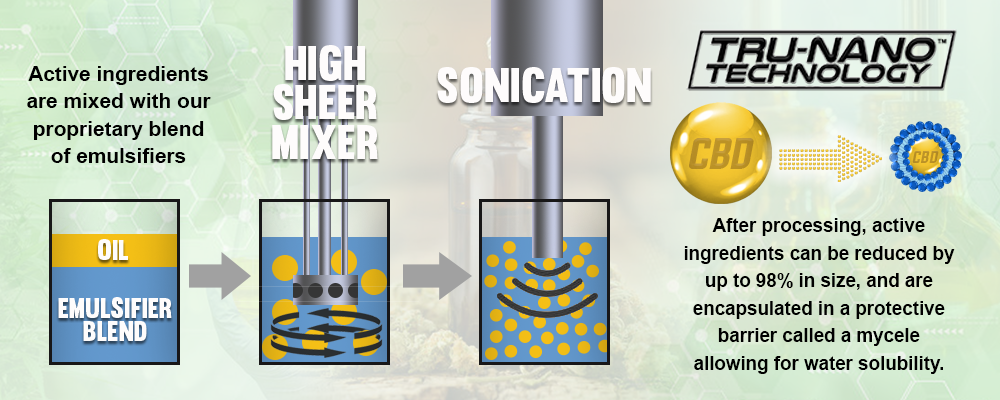
The Secret Sauce: Nano Emulsions
Nano emulsions are a type of emulsion, which is a mixture of two immiscible liquids (such as oil and water) stabilized by an emulsifying agent.
Increase the value of your raw materials with water solubility, increased bio-availability and increased shelf life.
Nano emulsions are a type of emulsion, which is a mixture of two immiscible liquids (such as oil and water) stabilized by an emulsifying agent. In a nano emulsion, the droplets of one liquid are reduced in size to the nanoscale, typically between 20-200 nm. This small size allows the droplets to remain evenly suspended in the other liquid, creating a stable mixture.
One of the key benefits of nano emulsions is their improved bioavailability. Because the small droplet size increases the surface area of the suspended liquid, it becomes more easily absorbed into the body. This can lead to greater efficacy of the active ingredients contained in the nano emulsion, compared to larger droplet sizes.
Nano emulsions are used in a variety of applications, including:
Food and beverage products: Nano emulsions are used to create stable mixtures of ingredients that would otherwise separate, such as flavor oils in soft drinks or functional ingredients in sports drinks.
Pharmaceuticals: By increasing the bioavailability of active ingredients, nano emulsions can improve the effectiveness of certain medications, including those delivered through the skin (such as transdermal patches) or orally.
Cosmetics: Nano emulsions are used in cosmetics to deliver active ingredients more effectively into the skin, leading to improved moisturization and anti-aging effects.
Nano emulsification is a process that involves the creation of extremely small droplets of one liquid within another liquid to form a stable emulsion. This process is used to improve the bioavailability and absorption of certain ingredients, such as lipophilic drugs, vitamins, and food additives, by increasing their solubility in aqueous environments.
Mixing: The ingredients, including the oil and water phases, are mixed together using high-shear equipment, such as a homogenizer, ultrasound probe, or high-pressure homogenizer. The high-shear mixing energy breaks down the oil droplets into much smaller sizes, typically in the range of 20 to 100 nanometers.
Stabilization: An emulsifying agent, such as a surfactant, is added to the mixture to stabilize the droplets and prevent them from aggregating or coalescing. The surfactant acts as a barrier between the oil and water phases, helping to maintain the stability of the emulsion over time.
Formulation: The resulting nanoemulsion is then formulated into the final product, which can be a topical cream, oral suspension, or food product.
Nano emulsification offers several advantages over traditional emulsification methods, including improved solubility and bioavailability, enhanced stability, and the ability to encapsulate a wide range of ingredients. Additionally, nano emulsions can be designed to have specific droplet sizes, compositions, and stability properties to meet the specific requirements of a given application. However, the process of nano emulsification can be challenging, as it requires precise control over the formulation and processing conditions to achieve a stable and homogeneous nano emulsion.

1959: Richard Feynman delivers a lecture entitled “There’s Plenty of Room at the Bottom,” in which he proposes the idea of manipulating and arranging individual atoms and molecules to create new materials and devices.
1986: K. Eric Drexler publishes his book “Engines of Creation: The Coming Era of Nanotechnology,” in which he introduces the concept of molecular nanotechnology and describes how it could be used to build nanoscale machines and devices.
1991: The National Nanotechnology Initiative (NNI) is established in the United States, providing a framework for coordinating and funding research in nanotechnology across multiple agencies and organizations.
1999: The International Conference on Nanotechnology is held in Houston, Texas, bringing together scientists, engineers, and researchers from around the world to discuss the latest advances and future directions of the field.
2001: The Nobel Prize in Chemistry is awarded to Eric S. Allett, Richard E. Smalley, and Robert F. Curl for their discovery of fullerenes, a class of carbon nanostructures that have since become an important area of research and development in nanotechnology.
Since its inception, nanotechnology has had a profound impact on a wide range of fields, including materials science, electronics, biomedicine, and energy, among others. Today, the field continues to evolve and grow, with ongoing research and development efforts aimed at further advancing our understanding of the properties and behavior of materials at the nanoscale, as well as developing new technologies and applications based on these principles.

Nano emulsions are a type of emulsion, which is a mixture of two immiscible liquids (such as oil and water) stabilized by an emulsifying agent.

The history of spray drying can be traced back to the late 19th century, when the process was first used to produce dried milk and

The history of nanotechnology can be traced back to the late 1950s and early 1960s, when scientists first began to explore the properties and behavior